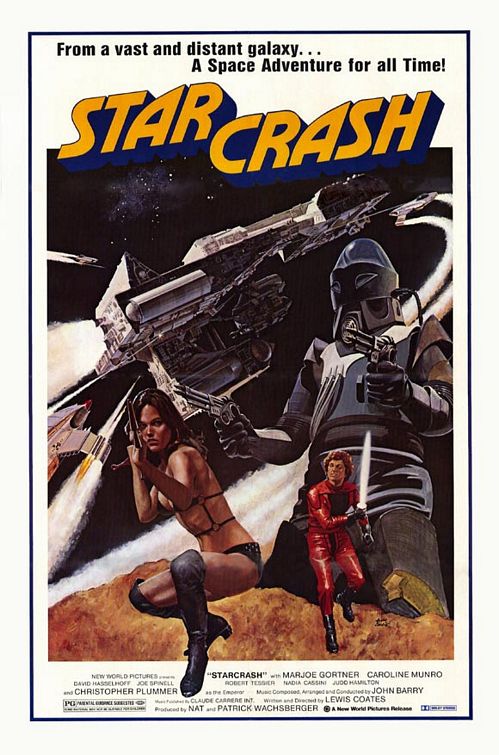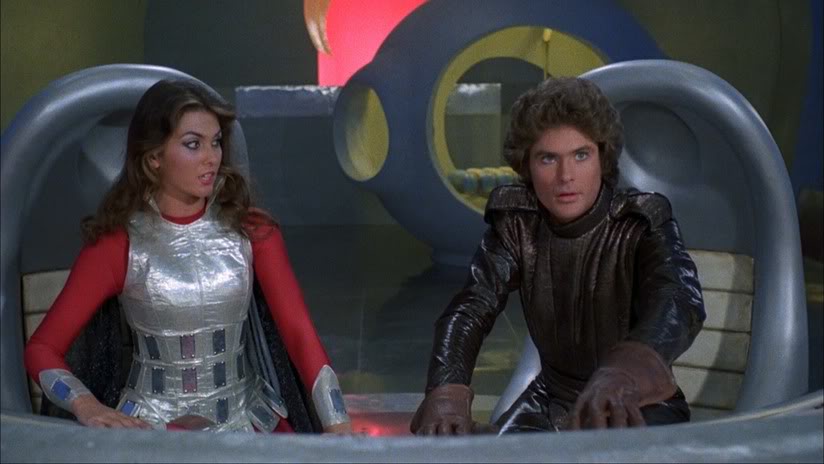Star Wars is the rare film whose influence on Hollywood cannot be overstated; following its smash success in 1977, theaters were hailed with a meteor storm of Star Wars cash-ins, rip-offs, and wannabes. Some imitators, like Battlestar Galactica, would prove surprisingly long-lived, while others like Space Mutiny and Laserblast (in which melting Mark Hamill action figure Kim Milford blows up a Star Wars billboard) would be destined for mockery on Mystery Science Theater 3000. Even film franchise elder statesman James Bond felt the space craze in the adaptation of Ian Fleming’s Moonraker, and classic science fiction properties Flash Gordon and Star Trek were revitalized for the big screen. Amid the mad rush to fill the gaps between the original Star Wars sequels, there emerged one colorful, campy space opera that became the archetypal Star Wars knock-off: Starcrash, a.k.a. the movie where David Hasselhoff is Princess Leia.
Released in 1979 by Roger Corman’s New World Pictures, Starcrash is the story of space pirate Stella Star (Caroline Munro), who, after being condemned to a life sentence on a penal colony planet, is freed on the condition that she find Prince Simon (David Hasselhoff), the missing son of the Emperor of the Galaxy (Christopher Plummer—yes, we’re supposed to believe he and Hasselhoff are father and son). Accompanied by her mystical navigator Akton (Marjoe Gortner) and Elle, a robot with the voice of a Southern small town sheriff, Stella encounters many obstacles in her galactic quest, including Amazons on horseback, a traitorous space cop, and the evil Count Zarth Arn (Joe Spinell)—who looks like Ming the Merciless redesigned by Count Chocula.
At first glance, the similarities to Star Wars are numerous and shameless. The very first scene mimics the famous slow reveal of the Star Destroyer moving through space. A roguish space outlaw is recruited to rescue the missing heir to a planetary throne. The evil count is named Zarth. And in the biggest “I cannot believe this movie wasn’t sued into oblivion” moment, Akton wields an honest-to-Obi-Wan lightsaber. There are a few slight tweaks to Star Wars’ now familiar plot: the sexes of the outlaw and captured royalty are reversed, giving us Stella Star and Prince Simon in place of Han Solo and Princess Leia; the nameless emperor of the universe is a kind and noble ruler, instead of a despot; and, interestingly, there are no direct analogues to boy hero Luke Skywalker. (Akton is more of an Obi-Wan figure, but with the perm of Chewbacca.)
Though the film orbits around Stella, she isn’t the brightest Star in the galaxy. The character of Han Solo casts a long shadow in modern science fiction; you can see him in Mal Reynolds and Star-Lord, but rarely do you see that kind of swaggering space pirate charm embodied in female characters. At the beginning of the film, Stella seems like she’ll be a blast. While being pursued, she sneers at Elle, “First you’ve got to catch me, you dirty cop!” You don’t expect lines like that in Star Wars, and moments like that give Starcrash a bit of exploitation film grit. So it’s disappointing, then, that for large chunks of the movie Stella is repeatedly captured by enemies, needs to be saved by Akton or Elle, or yells useless dialogue like “Look out!” or “Let go of me!” Caroline Munro is enthusiastic enough for the part, but Stella Star suffers from being what I call the Reverse Princess Leia.
In Star Wars, Princess Leia initially serves the role of the damsel in distress, the fairytale princess in the tower. But as performed by Carrie Fisher, the character becomes someone truly special and worthy of her iconic status in pop culture. Observe Leia’s steely resolve in her meeting with the cadaverous Grand Moff Tarkin, her refusal to betray the Rebellion even when it costs her Alderaan, and then her “Aren’t you a little short for a Stormtrooper?” quip, which she delivers even while facing imminent execution. And once she’s freed, Leia picks up a blaster and wastes no time showing the audience why she’s the leader of the Rebellion. By contrast, Stella’s lack of agency is disappointing, even after she saves the universe in the film’s final act. (Still, in fairness to Starcrash, when Stella is abducted by the Amazon queen and her female warriors, there are more women in a single scene than there are in all six Star Wars films combined.)
Starcrash’s bizarre cast is part of what gives the film its goofy charm. Besides Munro and Spinell, who would team up again in 1980 for the greasy, deeply unpleasant serial killer film Maniac, we have Marjoe Gortner as Akton. A semi-famous evangelist-turned-actor, Gortner’s casting as the mystical wannabe Jedi is a sly joke that the movie never fully commits to. Christopher Plummer, like Alec Guinness before him and Christopher Lee after him, brings a quiet gravity to the film in his few scenes as the Dignified Old White Guy in a Star Wars Movie. This is obviously a “wanted to be paid to spend a weekend in Rome” role for him, a complete throwaway, but Plummer admirably sells lines that sound like outtakes from Plan 9 From Outer Space. When Plummer’s Emperor says that the mission to save his only son is secondary to stopping Zarth’s secret weapon, we surprisingly feel his pain and resignation. And whither that smirking, permed prince, David Hasselhoff? This is a super early, pre-KITT, pre-Berlin Wall, pre-cheeseburger role for him, and he turns in a solid performance as the space hunk, Simon. People watching this for the first time aren’t soon to forget the image of Hasselhoff wielding a lightsaber against stop motion robots, and goofy abandon like that is what makes Starcrash the stuff of Midnight Movie screenings everywhere.
Directed by Luigi Cozzi, Starcrash retains a certain naïve, whacked-out charm that puts it ahead of slogs like Laserblast. It was clearly filmed with a fraction of Star Wars’ budget: the colorful stars appear to be Christmas tree lights, and some scenes look like they were filmed through a lava lamp. Actors are required to deliver lines like “I don’t understand, you never die” with straight faces. But in some ways, Starcrash embodies the spirit of 1930s Flash Gordon serials even more than Star Wars did; most of the film can be broken up into fast-paced vignettes, like Stella’s escape from the prison planet and her brush with evil Amazons, missing only “When we last left the sultry Stella Star…” title crawls.
Starcrash comes closest to cult movie greatness when it abandons the Star Wars imitations entirely. Forget Akton’s lightsaber, and instead give me a colossal robot woman with enormous metal breasts, or golden torpedoes that crash into Zarth’s ship, then open up to release the blaster-wielding soldiers inside (vaccuum of space be damned). Hell, you can even give me an obnoxious Southern robot sheriff that yells “Yee-haw!” as it flies through space. It’s impossible to separate Starcrash from its main inspiration, but with its unusual cast and colorful camp aesthetic, Starcrash is a bizarre relic of a time when Star Wars ruled the box office.
We’re writing about topics relating to that there galaxy far, far away throughout 2015 for a little event we’re calling The Year of Star Wars. Check it out!



